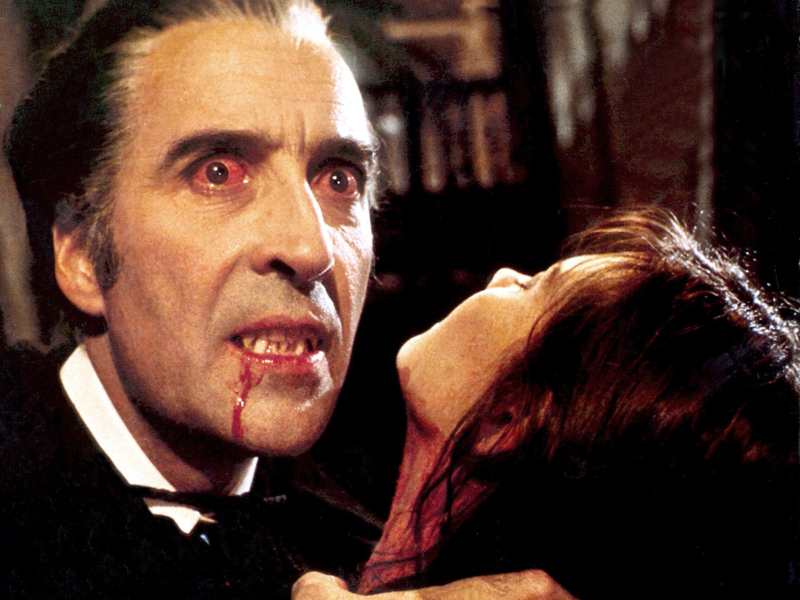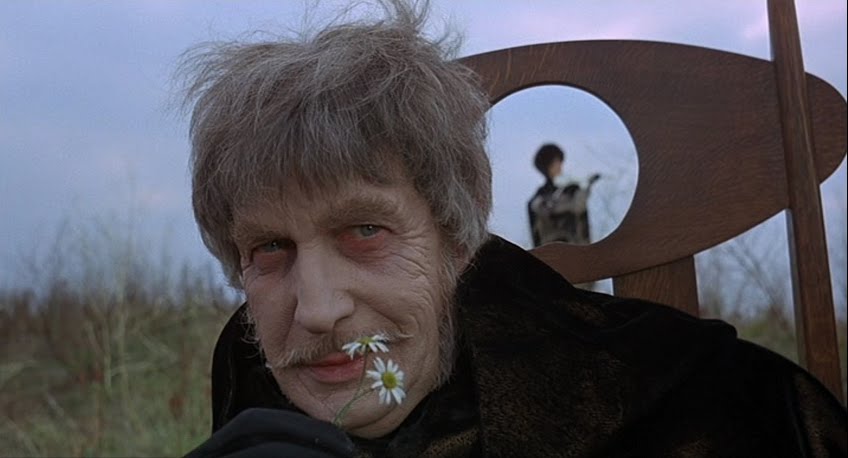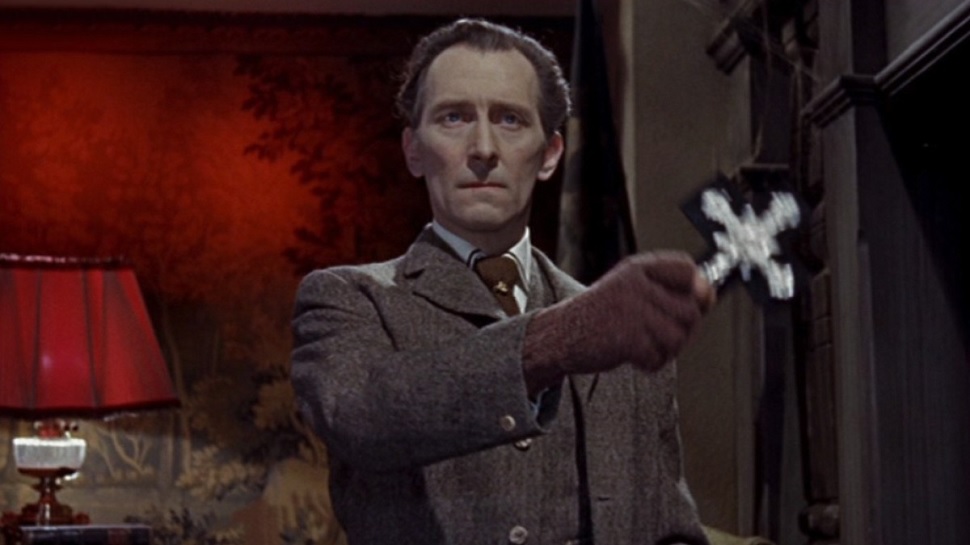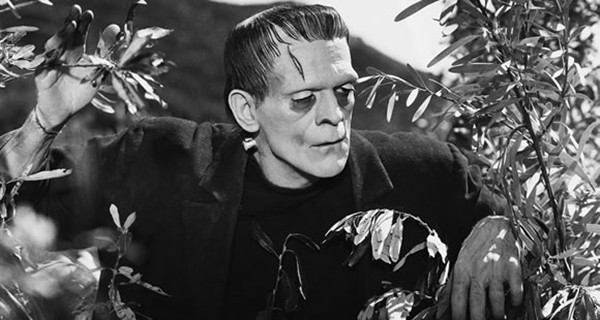5. Bela Lugosi

In truth Bela Lugosi’s film career is a tragic one, where Universal seemed to dispense of him rather quickly after he had helped make the studio famous the world over with his haunting portrayal of Dracula. Of course Universal have cemented Lugosi’s legacy too as he became the first person on screen authorized to play the famous count. Boris Karloff once queried the reason that Lugosi wasn’t able to consistently star in the bigger horror pictures and he commented that Lugosi’s English was no good. However that is debatable though it does seem that his heavy accent was a factor.
Lugosi was 47 before he starred in a horror movie which was of course the all time classic Dracula. The way he played the count has been repeated ever since and has always been the yardstick for up and coming actors in the role. Dracula kick started the first of what would be 34 horror movies for the legend.
Not only did Lugosi star as the first Dracula but he also starred in the first ever zombie movie, White Zombie. He also teamed up with the great Boris Karloff in no less than 8 movies, a few of them drawn from Edgar Allan Poe stories in the form of Murders in the Rue Morgue, The Black Cat and The Raven. Arguably one of Lugosi’s most famous roles was in The Invisible Ray where ne notably upstaged Karloff.
Lugosi starred in a few Frankenstein movies including his memorable role as Ygor in the classic Son of Frankenstein. He also became the monster in The Ghost of Frankenstein. In the 1930’s alone, Lugosi had starred in around twenty horror movies.
However by the 1940’s and with his alleged drug problem Universal either dropped him or gave him minor roles. In the classic horror whodunit, Night Monster he is reduced to the role of a butler. Universal also disregarded him as Dracula even though the studio would go on to make 3 sequels. However he did return as the caped one in Return of the Vampire although for obvious legal reasons Dracula couldn’t be mentioned.
By the middle of the decade, RKO pioneer Val Lewton did something wonderful and cast Lugosi in The Body Snatcher alongside his friend Karloff; this would be the last time the pair would ever act together. It was fitting given that the movie is perhaps one of the best horror films of that decade.
Towards the end of the 40s Universal finally yielded and Lugosi played Dracula once again in Abbott and Costello Meet Frankenstein. It was a role that he certainly cherished.
In the 1950’s and with his health failing and money problems he accepted to work on some Ed Wood films, he of the low budget maker. His final films were mostly forgettable although he did end up starring in Plan 9 from Outer Space, not that he knew it as it had been pieced together from different ideas. At least that movie gained some cult status, by then it mattered little, Lugosi was long dead and his final wish being buried in Dracula’s cape was granted.
4. Christopher Lee

Christopher Lee starred in 57 horror movies, or one every year since his horror debut in The Curse of Frankenstein where he played the monster and Peter Cushing played the Baron.
Lee and Cushing would become the faces of Hammer Horror, and Lee only further impressed when he was cast as Count Dracula. He played the role relentlessly as if he was born to take over from Bela Lugosi’s reigns. Lee would go on to star in another 7 Dracula films, although the irony in his roles was that Lee himself didn’t want to make any Dracula sequels and ended up despising the character at least publically.
Whilst Lee would heavily work for Hammer and the rival studio Amicus, he was never afraid to spread his wings and because of this became a better actor for it. Corridors of Blood saw him in a memorable role playing a devious murdering cockney called Resurrection Joe, he starred opposite Boris Karloff. He would frequently be happy to tour around Europe and make horror movies with largely unknown directors at least on his shores, one of which was Mario Bava for The Whip and the Body.
Lee continued to work with Cushing and the two of them became best friends away from filming. It was interesting that usually Lee would play the evil character to Cushing’s good will eventually conquer. For Amicus, Lee played one of his very wicked roles in The City of the Dead a superb shocker that still surprises today. And still the great movies rolled out in the 60s one after the other- The Gorgon, Terror in the Crypt, Dr Terror’s House of Horrors, The Skull and Theater of Death to name a few.
His cameo role in thriller horror Taste of Fear sometimes known as Scream of Fear was one of his favorite movies. Lee turned a very average film Rasputin the Mad Monk into a great one just with his presence. Despite the seriousness of his acting there was also the humor, his gambling ways in The Two Faces of Dr Jekyll was a treat. His character in The Curse of the Crimson Altar enters a creepy mansion and blurts out, “you’d expect to see Boris Karloff in here”, and then Karloff himself enters. In the 1960’s Lee starred in 42 movies and most of those were cementing his horror status.
In the early 70s he continued to work with Cushing where they appeared in 7 movies in just three years. However the 70s was a huge change for horror and with the likes of Rosemary’s Baby, Repulsion and The Exorcist making horror more adult Lee swiftly changed with the times. His devastating role as Lord Summerisle in The Wicker Man still resonates today. He also starred in Hammer’s last horror movie the 1976 film, To the Devil a Daughter where he played a Roman Catholic priest who practicing Satanism, some of the scenes in the film shocked Lee’s long standing fans.
Shortly afterwards and with the collapse of Hammer Lee moved to America and starred in many dramas and exploitation action flicks. He even became friends with Chuck Norris when he co starred with him on the movie An Eye for an Eye. Lee did return to horror though in 1983 when he starred in House of the Long Shadows, which featured the greats of horror actors in Cushing, Vincent Price and John Carradine. This movie marked the last time that Lee would work with Cushing, a movie relationship that had lasted four decades.
In the 80s Lee made some questionable movie decisions, Howling II was certainly one of them, which he later regretted. In the late 90s he returned to the horror genre with Tales of the Mummy and Sleepy Hollow where he met Jonny Depp and they became close friends until Lee’s death last year.
Lee is best known to a new generation for his epic roles in The Lords of the Rings and the Star Wars prequels, only ensuing that his legacy will live on for many years to come.
3. Vincent Price

Nobody in the history of horror movies had such a distinctive voice as Vincent Price; his tone was absolutely perfect for it. Price was an outstanding actor who starred in over 30 horror movies in a sweeping career. It is often mooted that Price’s horror career didn’t start until 1953 and his infamous role in House of Wax. However his first touch of horror was actually back in 1939 when he starred alongside Boris Karloff and Basil Rathbone in Tower of London.
Incidentally Price also starred in the remake some 23 years later. Price also starred in the long awaited sequel to the Invisible Man with the Invisible Man Returns where he played the title character. It should also be noted that Price’s voice can be heard in Abbott and Costello Meet Frankenstein from 1948.
House of Wax certainly did establish Price though and its 3D gimmicks at the time only helped propel the movie. House of Wax was a remake of The Mystery of the Wax Museum (1933) and the movie went on to make 23 times its budget. The following year presented Price with the enjoyable The Mad Magician though the fact that the plot involved Price’s character being ripped off did seem similar to House of Wax.
If truth be told by the end of the 1950’s Price still wasn’t known in cinema as a horror actor and by now he had been in the acting profession for 20 years. But this all changed with his appearance in The Fly (1958), although he didn’t play the title character and was used more in the supporting role. That same year maverick director William Castle cast him in the ever popular House on Haunted Hill where he played a wealthy man who invited a group of people round to his mansion and betted that they couldn’t last the night there. Price wrapped up the decade with three more horrors, The Tingler, The Bat and the sequel to The Fly- Return of the Fly.
It would be the next five years though and the partnership with Roger Corman that would cement Price’s horror legacy. The Fall of the House of Usher is arguably one of Price’s greatest acting roles as Corman and himself took on some of the great works of Edgar Allan Poe.
And this was only the beginning. The Raven followed as did The Comedy of Terrors, Tales of Terror, The Masque of the Red Death, The Tomb of Ligeia. There were other horrors such as Diary of a Madman, The Haunted Palace, The Last Man on Earth and one of the best horror anthologies ever made in Twice Told Tales. In those first five years of the 60s including other genres, Price had starred in a remarkable 20 movies.
By 1965 he was considered a horror legend although he did take a three year break from the genre; this included his stint on various episodes of Batman as Egghead. In 1968 he returned to horror when he narrated the horror anthology Spirits of the Dead. He then starred in his most violent film the classic Witchfinder General. In America the movie was called The Conqueror’s Worm and the poster read ‘Leave your children at home and if you are squeamish stay home with them’. This would mark Price’s 75th movie.
As Price turned 60 at the beginning of the 1970’s he hardly slowed down, Scream and Scream Again gave him his first opportunity to work with British horror legends Christopher Lee and Peter Cushing and he established a new ‘horror character’ in the shape of Dr Anton Phibes in the Abominable Phibes movies. His love for Edgar Allan Poe was underlined when he sat down and read Poe’s stories with his glorious accent; this was later released as An Evening of Edgar Allan Poe.
Price of course was also known as hamming his performances up and under his devilish smile was often a tongue in cheek performance. This was tested so well in movies such as Madhouse and Theater of Blood. In 1980, Price finally played a vampire in the wraparound story of the anthology The Monster Club and then three years later starred in House of the Long Shadows with all of the horror legends.
For a newer generation of fans growing up in the 80s Price will always be remembered as the voice in Michael Jackson’s superb Thriller video which saw the dead rise from their graves- Price’s laugh was spectacular and ghoulish just as it should have been, and the old star had lost none of his magic.
Inevitably in the 80s Price slowed down but we still got a couple of horror anthologies in which in both he played in the wraparound story. First Escapes where he played a devilish post man and then From a Whisper to a Scream which to this day remains underrated. His final horror movie was the horror comedy, Dead Heat in 1988 capping a horror career in film that lasted for almost 50 years.
2. Peter Cushing

Just hearing his name can leave your hair standing on edge although in reality Peter Cushing was one of the most friendliest and elegant gentlemen in the movie business. It’s strange to think that Cushing was 44 before he undertook his first horror movie and had been acting in the business for over 20 years. All of that changed seemingly overnight when he was cast as the Baron in Hammer Horror’s first gothic horror, The Curse of Frankenstein.
Hammer had changed the emphasis from Universal movies that had made the monster the prime role. But Hammer switched that to the Baron; in each sequel he becomes more demented and unlikable. In all Cushing played the Baron 6 times between 1957 and 1974.
Cushing was also known as the hero figure when he played Van Helsing in Dracula. He appeared in the first one, Horror of Dracula and its sequel the excellent Brides of Dracula, then took a decade’s break from the role until 1972’s Dracula AD 72. But Cushing was a staple and figurehead at Hammer’s new line of film genre. He was ever working and secured another huge role in The Mummy again alongside his friend Christopher Lee, who incidentally played the monster.
One of his greatest roles was actually a non Hammer movie where he played Dr Robert Knox in a tale inspired from the Burke and Hare case, The Flesh and the Fiends. But at Hammer he was busy in the 60’s and gave superb performances in the likes of The Gorgon. Cushing also starred in a few features from Hammer’s rivals Amicus, who had started churning out horror anthologies. He played the evil tarot card reader with a heavy European accent in Dr Terrors House of Horrors, and played alongside Jack Palance in where the pair fights it out over who has the greatest Edgar Allan Poe collection!
Cushing went onto star in many of Amicus’ anthologies which included The House that Dripped Blood, Tales from the Crypt and arguably their best portmanteau in Asylum. However it is his performance in Tales from the Crypt where he played the lonely old grubby but sweet Arthur Grimsdyke who entertains the local kids only to be threatened by his stuck up neighbors with eviction, that won the hearts of many a viewer.
With the changing of the times and horror evolving Cushing dipped his toes into new territory with performances that upped the violence in such movies as Corruption (1968) and The Vampire Lovers (1970) which for the time justified its X rating with female full frontal nudity.
However in 1971 his wife Helen died and the spark went off in Cushing’s eyes. He no longer wanted to live but his religious beliefs at least pulled him through, so much so that he undertook every piece of work that was given to him. But his performances were always laden with grief over his loss and this continued throughout his life.
In the four years after his wife’s passing, Cushing starred in a remarkable 21 horror movies. To his credit most of them were worth his time. One such movie, The Ghoul remains one of his most personal films. He requested that a real life photo of his wife appear in several shots of the movie and his character has lost his wife and when Cushing speaks, he is clearly thinking of Helen, those watery eyes were indeed real.
In 1977 he was still making horror movies in the shape of Nazi zombies in Shockwaves and starred in a Canadian anthology with the cat inspired tales of The Uncanny. But those were eclipsed when he starred as Grand Moff Tarkin the Nazi like commander in George Lucas’ classic Star Wars. Indeed Cushing could lay claim to being the most prolific screen killer in the history of movies. Note he is the one that orders the destruction of Princess Leia’s planet!
In the 1980’s Cushing only took on two more horror projects but in some ways they would be close to his heart. The first was starring in Hammer Horror’s House of Horror TV show which had started airing. His segment was as the Nazi like pet shop opener in The Silent Scream. The other was starring in House of the Long Shadows with all the horror legends and fittingly this would mark his final ever horror movie.
In 1994 and with just months to live Cushing teamed up with Christopher Lee and the two of them narrated for Hammer Horror and a TV show that would be aired that summer. This rounded up Cushing’s association with Hammer Horror which had lasted a glorious 37 years. Peter Cushing was a fine actor and was the absolute best in his genre of keeping in character even if the camera wasn’t centrally on him.
1. Boris Karloff

Boris Karloff was born William Pratt in the 19th century and he would travel a long road and distance before establishing himself as arguably the finest movie horror icon of all time. Karloff started his horror career in a small role in the John Barrymore film The Mad Genius (1931) but in the same year his career path changed significantly when he played Universal’s most famous and iconic of monsters in Frankenstein.
Directed by James Whale, not only was Frankenstein as big a statement on the horror film as Nosferatu released a decade earlier but it was also one of the finest horror movies ever made. Karloff later appeared in the much hailed sequel Bride of Frankenstein, where the monster speaks and also Son of Frankenstein.
In between then Karloff remained incredibly busy. He teamed up with Bela Lugosi on numerous occasions and starred in another James Whale classic The Old Dark House. The Black Room (1935) dazzled movie goers as they were treated to two Karloff’s in the same scenes, where Karloff played an evil brother. Karloff also under took many different film genres and perhaps one of his most famous was as James Lee Wong in the Wong series of movies.
His horror and crime capers continued in the 1940’s and he starred in the final Frankenstein movie outside of the Abbott and Costello ones called House of Frankenstein. Here he didn’t play the monster but the final scene of him drowning with it was certainly fitting.
The decade though for Karloff was most notable with his teaming up of Val Lewton. Lewton wanted to make serious suggestive horror movies for adults. His one drawback was the lack of budget that RKO could give him and also some of the ludicrous titles that he was forced to work with. One such title was I walked with a Zombie, which would suggest nothing more than a B movie, but Lewton proved time and again that his movies far and away punched above their weight and their titles.
Karloff became attracted to this because he wanted to escape the monster mash up at Universal. Karloff starred in three Lewton vehicles; Bedlam, Isle of the Dead and The Body Snatcher. All three were superb treats for horror fans, although it is the latter that struck the heaviest chord. In The Body Snatcher Karloff played Cabman Gray a devious although polite at times man who would provide bodies to the local doctor played by Henry Daniel. Karloff’s performance was simply breathtaking and is arguably his best role of his career.
After this he starred in a couple of Abbott and Costello horror comedies and branched out on different genres in the 1950’s. However he returned with such classics as The Grip of the Strangler where he simply contorted his face to get an evil look and the underrated Corridors of Blood which had a five year delay in release.
At the beginning of the 1960’s Karloff hosted his own horror anthology show, Thriller which rivaled in some ways Alfred Hitchcock’s show. Although Thriller was certainly more horror, the show for the most part was superb television and Karloff himself starred in a few tales. The show lasted 67 episodes over two seasons. Karloff also starred and narrated Mario Bava’s classic Black Sabbath horror anthology and starred alongside a young Jack Nicholson in Roger Corman’s The Terror.
Karloff teamed up with Vincent Price on a couple of movies, namely the horror comedies The Raven, in which Karloff had starred in the original some 30 years earlier and The Comedy of Terrors. By the late 60’s Karloff became heavily wheelchair bound but he still made starring roles in the likes of The Curse of the Crimson Altar, Die Monster Die and The Sorcerers. He played himself in the excellent Targets and then regrettably signed up for three low budget Mexican horror movies, which were actually released after his death in 1969.
Despite his horror leanings and the monsters he played, outside of the makeup Karloff was an extremely approachable human being. Every year since 1940 he dressed up as Santa Claus delivering presents to a Baltimore children’s hospital. He also protected workers rights in the industry and would always stay behind on set to help the rookies out.
Karloff went back to England to die and settled in Hampshire, England in the village of Bramshott where he passed away. The village is known for its hauntings and reportedly many ghosts have been seen at night walking down the lanes, one of which is yours truly……